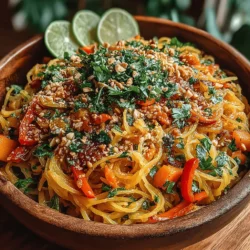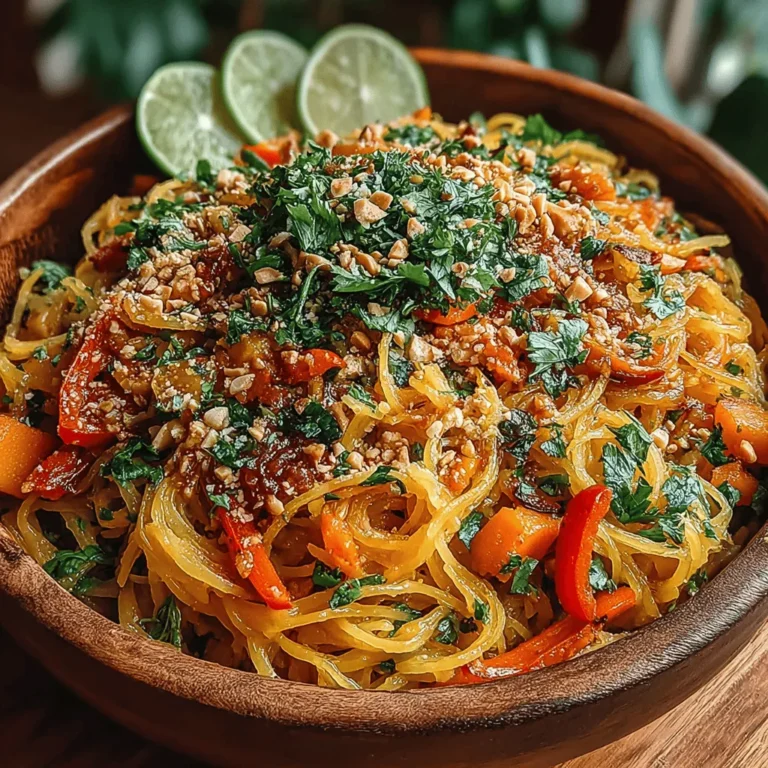Wholesome Spaghetti Squash Pad Thai: A Nutritious Twist on a Classic Favorite
Introduction
Pad Thai, a staple of Thai cuisine, is celebrated for its harmonious blend of flavors and textures. This iconic dish typically features stir-fried rice noodles, a mix of proteins, and an array of vibrant vegetables, all brought together with a savory sauce. With its roots in Thailand, Pad Thai has gained popularity worldwide, becoming a go-to option for those seeking a delicious and satisfying meal. However, traditional Pad Thai can sometimes be heavy in carbohydrates and calories, which is where our recipe for Spaghetti Squash Pad Thai comes into play.
In this wholesome take on the classic, we replace conventional noodles with spaghetti squash, a nutrient-dense vegetable that offers a low-carb alternative without sacrificing flavor or satisfaction. Spaghetti squash is not only versatile but also packed with vitamins and fiber, making it an excellent choice for those aiming for a healthier diet. This recipe is designed to be both easy to prepare and incredibly satisfying, allowing you to enjoy the essence of Pad Thai while boosting your nutritional intake.
Understanding Spaghetti Squash
Spaghetti squash is a unique winter squash that, when cooked, naturally separates into long, thin strands resembling spaghetti. This intriguing vegetable has a mild, slightly sweet flavor that pairs beautifully with a variety of sauces and seasonings, making it an ideal canvas for our Pad Thai-inspired dish.
Nutritionally, spaghetti squash is a powerhouse. It is low in calories—approximately 42 calories per cooked cup—making it a fantastic option for anyone looking to reduce their caloric intake. It is high in vitamins A and C, both of which are vital for maintaining a healthy immune system and promoting skin health. Additionally, spaghetti squash is an excellent source of dietary fiber, which aids digestion and helps keep you feeling full longer.
When selecting spaghetti squash, look for one that is firm, with a smooth, unblemished rind. The color can vary from pale yellow to deep orange, but the key is to choose a squash that feels heavy for its size. For optimal freshness, store spaghetti squash in a cool, dry place, away from direct sunlight. It can last for several weeks in this environment, making it a convenient staple in your kitchen.
Ingredients Breakdown
Creating Spaghetti Squash Pad Thai requires a thoughtful selection of ingredients that not only support the dish’s flavor profile but also enhance its nutritional value. Here’s a breakdown of the key ingredients you’ll need:
1. Spaghetti Squash: As the star of the dish, the spaghetti squash serves as a low-carb noodle substitute, providing a satisfying base for the Pad Thai.
2. Olive Oil: This heart-healthy oil is essential for sautéing the vegetables and adds a richness to the dish. Olive oil is packed with monounsaturated fats, which can help reduce inflammation and improve heart health.
3. Garlic and Onion: These aromatics are foundational to many cuisines, including Thai. Garlic adds a pungent flavor while also offering numerous health benefits, such as improved immune function and reduced blood pressure. Onions contribute sweetness and depth to the dish.
4. Colorful Vegetables: Incorporating a variety of vegetables not only enhances the visual appeal of your Pad Thai but also ensures a broad spectrum of nutrients. Bell peppers, carrots, and snap peas are excellent choices, providing vitamins, antioxidants, and fiber.
5. Protein Options: You can choose between eggs or silken tofu for your protein source. Eggs bring richness and a traditional touch, while silken tofu offers a plant-based alternative that is equally satisfying.
6. Tamari/Soy Sauce: This savory sauce is crucial for achieving the signature flavor of Pad Thai. Tamari is a gluten-free option that complements the dish beautifully.
7. Peanut Butter: This ingredient adds creaminess and a hint of sweetness, essential for balancing the flavors in Pad Thai. Look for natural, unsweetened peanut butter for a healthier choice.
8. Lime Juice: Fresh lime juice brightens the dish and adds a zesty kick that enhances all the other flavors.
9. Brown Sugar or Coconut Sugar: A touch of sweetness is vital in Pad Thai. Both brown sugar and coconut sugar are great options, with coconut sugar providing a lower glycemic index alternative.
10. Red Pepper Flakes: For those who enjoy a bit of heat, red pepper flakes allow you to customize the spice level of your dish.
Preparation Steps Explained
Prepping the Spaghetti Squash
To begin your culinary adventure, you’ll need to roast the spaghetti squash to achieve that perfect noodle-like texture. Start by preheating your oven to 400°F (200°C). Carefully cut the spaghetti squash in half lengthwise, and scoop out the seeds. Drizzle a bit of olive oil on the cut sides and sprinkle with salt and pepper to enhance the flavor.
Place the squash cut-side down on a baking sheet lined with parchment paper. Roast in the preheated oven for about 30 to 40 minutes, or until the flesh is tender and easily pierced with a fork. Once it’s cooked, remove it from the oven and allow it to cool for about 10 minutes. This resting period is crucial; it will make shredding the squash into strands much easier and help maintain the integrity of the “noodles.”
After it has cooled, use a fork to gently scrape the flesh of the squash, creating long strands that resemble traditional noodles. Set these aside while you prepare the rest of the dish.
Making the Flavorful Sauce
While your spaghetti squash is roasting, you can start crafting the flavorful sauce that will bring your Pad Thai to life. In a small bowl, combine tamari or soy sauce, peanut butter, lime juice, and a touch of brown sugar or coconut sugar. Whisk these ingredients together until smooth, adjusting the sweetness and acidity to your taste. If you like a bit of heat, feel free to add a pinch of red pepper flakes to the mix.
This sauce will serve as the backbone of your Spaghetti Squash Pad Thai, infusing the dish with a delightful array of flavors that are both comforting and invigorating. As you prepare the rest of the ingredients, keep this sauce handy for quick incorporation into your dish, ensuring that every bite is packed with the authentic taste of Pad Thai.
In the next section of this article, we will delve deeper into the cooking process, guiding you through the steps to assemble and cook your Spaghetti Squash Pad Thai to perfection. Stay tuned to transform this nutritious twist on a classic into a delicious meal that the whole family will love.
{{image_2}}
Step-by-Step Guide to Creating a Creamy, Savory Sauce
The sauce is the soul of any Pad Thai, and this Spaghetti Squash Pad Thai is no exception. To create a creamy, savory sauce that ties the dish together, you’ll need to blend a few key ingredients.
Ingredients for the Sauce:
– 3 tablespoons of peanut butter (or almond butter for a nut-free option)
– 2 tablespoons of soy sauce (use tamari for gluten-free)
– 1 tablespoon of lime juice (freshly squeezed)
– 1 tablespoon of maple syrup (or agave syrup)
– 1 teaspoon of sesame oil
– 1-2 teaspoons of Sriracha (adjust based on your spice preference)
– 1 clove of garlic, minced
– 1 teaspoon of grated ginger
Instructions:
1. Mix Ingredients: In a medium bowl, combine the peanut butter, soy sauce, lime juice, maple syrup, sesame oil, Sriracha, minced garlic, and grated ginger.
2. Whisk Until Smooth: Use a whisk or a fork to blend all the ingredients until you achieve a smooth consistency. If the sauce is too thick, you can add a splash of water to thin it out.
3. Taste and Adjust: Before adding to your dish, take a moment to taste the sauce. Adjust the flavor by adding more lime juice for acidity, maple syrup for sweetness, or Sriracha for heat, depending on your preference.
The creamy sauce not only adds richness but also enhances the overall experience of the Spaghetti Squash Pad Thai. It clings to the strands of squash, ensuring each bite is packed with flavor.
Sautéing the Vegetables
The next crucial step in your Spaghetti Squash Pad Thai is sautéing the vegetables. This process not only develops flavor but also preserves the nutrients, making your dish as healthy as it is delicious.
Importance of Cooking Vegetables
Cooking vegetables helps to enhance their natural flavors while also making them easier to digest. In this recipe, we’ll use bell peppers, carrots, and green onions, but feel free to add any of your favorites.
Techniques for Perfect Sautéed Texture
1. Preheat Your Pan: Start by preheating a large skillet or wok over medium-high heat, adding a tablespoon of oil (olive or coconut works well).
2. Add Vegetables: Once the oil is hot, add your chopped vegetables. Stir-fry them for about 3-5 minutes, or until they are tender-crisp.
3. Season Lightly: Sprinkle a pinch of salt and pepper to enhance the flavors as they cook.
4. Watch for Color: You want your vegetables to retain their vibrant colors and crunchiness, which is a sign they are perfectly sautéed.
The sautéed vegetables will provide a delightful contrast to the softness of the spaghetti squash, creating a balanced texture in your dish.
Cooking the Eggs or Tofu
The protein component is vital for making your Spaghetti Squash Pad Thai satisfying. Depending on your dietary needs, you can choose between eggs or tofu.
Cooking Process for Eggs
1. Scramble: If you opt for eggs, push the sautéed vegetables to one side of the pan, add a little more oil, and crack in 2-3 eggs.
2. Cook Until Set: Stir gently until the eggs are fully cooked but still soft. Combine them with the vegetables before moving to the next step.
Cooking Process for Tofu
1. Prepare Tofu: If you prefer tofu, use firm or extra-firm tofu. Press it to remove excess moisture, then cut it into small cubes.
2. Sauté Tofu: Add the tofu to the pan with a bit of oil and sauté until golden brown and crispy, about 5-7 minutes. This adds a great texture to the dish.
Benefits of Each Protein Option
– Eggs: A great source of protein and essential nutrients, perfect for those who enjoy animal products.
– Tofu: A fantastic plant-based protein source, rich in calcium and iron, ideal for vegans and vegetarians.
Combining Ingredients for the Final Dish
Now that you have your sauce, sautéed vegetables, and protein ready, it’s time to bring everything together.
Tips for Evenly Mixing Ingredients
1. Add Spaghetti Squash: Start by adding the cooked spaghetti squash strands to the pan with the sautéed vegetables and protein.
2. Pour the Sauce: Next, drizzle your creamy sauce over the mixture, ensuring it coats everything evenly.
3. Toss Gently: Use tongs or a spatula to gently toss all the ingredients together. Be careful not to overcook the vegetables; you want them to remain vibrant and crunchy.
Importance of Heating Through
Make sure everything is heated through, allowing the flavors to meld together without overcooking the vegetables. The goal is a hot, cohesive dish that’s ready to serve!
Serving Suggestions
Presentation matters, especially when it comes to a dish as colorful as Spaghetti Squash Pad Thai. Here are some creative ideas for serving:
Creative Presentation Ideas
– Nestled in a Half Squash: Serve your Pad Thai in the hollowed-out half of the spaghetti squash for a rustic presentation.
– On a Plate with Garnishes: Place the Pad Thai on a flat plate and sprinkle with chopped cilantro, crushed peanuts, and lime wedges for a pop of color.
Enhancing Flavor and Visual Appeal
Garnishes not only elevate the visual aspect but also add layers of flavor. Use:
– Chopped Peanuts: For a crunchy texture.
– Cilantro or Basil: Fresh herbs add brightness.
– Lime Wedges: A squeeze of lime just before eating enhances the dish’s acidity.
Pairing with Other Dishes or Beverages
For a complete meal, consider pairing your Spaghetti Squash Pad Thai with:
– Spring Rolls: Fresh or fried spring rolls complement the dish perfectly.
– Green Salad: A light green salad can balance the richness of the Pad Thai.
– Beverages: A chilled Thai iced tea or coconut water can enhance the dining experience.
Nutritional Analysis
One of the best aspects of this Spaghetti Squash Pad Thai is its nutritional profile. Let’s break down the content per serving:
Nutritional Breakdown
– Calories: Approximately 250 calories per serving
– Protein: 12-15 grams (depending on the protein choice)
– Fat: 10 grams (mostly healthy fats from peanut butter and oil)
– Fiber: 4-5 grams (thanks to the spaghetti squash and vegetables)
Comparison with Traditional Pad Thai
Traditional Pad Thai typically contains:
– Calories: Around 400-600 calories per serving
– Fat: Often higher due to oils and sugars added in the sauce
– Fiber: Less fiber due to the use of rice noodles instead of spaghetti squash
Health Benefits
This recipe offers a lower-calorie alternative without sacrificing flavor. The use of spaghetti squash increases the fiber content while lowering carbs, making it a great option for those looking to maintain a balanced diet without feeling deprived.
Conclusion
Creating Spaghetti Squash Pad Thai is not only a delightful cooking experience but also a celebration of healthy eating. With its creamy sauce, vibrant vegetables, and the option of protein, this dish brings together flavors and textures that cater to a variety of dietary preferences.
Embrace the versatility of spaghetti squash and explore its potential in various recipes beyond just Pad Thai. Every bite of this dish is a reminder that healthy eating doesn’t have to compromise on flavor. So gather your ingredients, follow the steps, and enjoy a meal that’s both nourishing and delicious!


